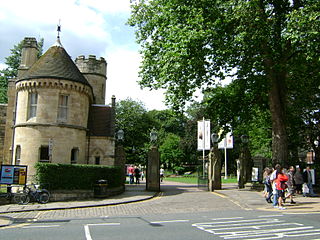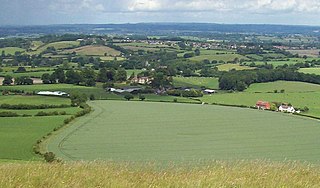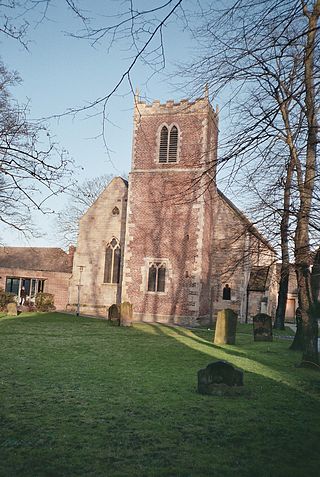
Glastonbury is a town and civil parish in Somerset, England, situated at a dry point on the low-lying Somerset Levels, 23 miles (37 km) south of Bristol. The town had a population of 8,932 in the 2011 census. Glastonbury is less than 1 mile (2 km) across the River Brue from Street, which is now larger than Glastonbury.

Canterbury Cathedral is the cathedral of the archbishop of Canterbury, the leader of the Church of England and symbolic leader of the worldwide Anglican Communion. Located in Canterbury, Kent, it is one of the oldest Christian structures in England and forms part of a World Heritage Site. Its formal title is the Cathedral and Metropolitical Church of Christ, Canterbury.
The Royal Academy of Music (RAM) in London, England, is one of the oldest music schools in the UK, founded in 1822 by John Fane and Nicolas-Charles Bochsa. It received its royal charter in 1830 from King George IV with the support of the first Duke of Wellington.

St Stephen's House is an Anglican theological college in Oxford, England. From 2003 to 2023 it was a permanent private hall of the University of Oxford.

Headingley is a suburb of Leeds, West Yorkshire, England, approximately two miles out of the city centre, to the north west along the A660 road. Headingley is the location of the Beckett Park campus of Leeds Beckett University and Headingley Stadium.
The London Bach Society is a society devoted to performing the music of Johann Sebastian Bach (1685–1750) with small, professional forces, using period instruments in order to obtain an authentic style of interpretation.
York had around 45 parish churches in 1300. Twenty survive, in whole or in part, a number surpassed in England only by Norwich, and 12 are used for worship. This article consists of a list of medieval churches which still exist in whole or in part, and a list of medieval churches which are known to have existed in the past but have been completely demolished.

The Church of St Augustine of Hippo in Lyttelton Road, Edgbaston, Birmingham, England, is a parish church in the Church of England.

The York Museum Gardens are botanic gardens in the centre of York, England, beside the River Ouse. They cover an area of 10 acres (4.0 ha) of the former grounds of St Mary's Abbey, and were created in the 1830s by the Yorkshire Philosophical Society along with the Yorkshire Museum which they contain.

Corsley is a hamlet and civil parish 3 miles (5 km) west of Warminster in Wiltshire, England. The parish is on the county border with Somerset; the Somerset town of Frome is about 3 miles (5 km) to the northwest. The largest settlement in the parish is Corsley Heath, which is on the A362 Warminster-Frome road.

The Church of St Mary, Ecclesfield, is situated on Church Street in the village of Ecclesfield, Sheffield, South Yorkshire, England. It is situated 4.3 miles (7 km) north of the city centre. It is a Grade I listed building, one of only five within the Sheffield city boundary. It was originally the parish church for Hallamshire, one of the largest parishes in England and in the seventeenth century was known as the "Minster of the Moors" due to its then rural situation.
A voluntary aided school is a state-funded school in England and Wales in which a foundation or trust contributes to building costs and has a substantial influence in the running of the school. In most cases the foundation or trust owns the buildings.

Saint George is the patron saint of England in a tradition established in the Tudor period, based in the saint's popularity during the times of the Crusades and the Hundred Years' War.

St Margaret's Church, King's Lynn, entitled King's Lynn Minster since 2011, is a Grade I listed parish church in the Church of England in King's Lynn. The building dates from the 12th to 15th centuries, with major restoration of the nave in the 18th century. Five of its ten bells and its organ also date back to the mid-18th century.
Classical music in Birmingham began in the late Middle Ages, mainly devotional music which did not survive the Reformation. Evidence is scant until the years following the Restoration of the Monarchy in 1660, when Birmingham's economy boomed. This was reflected in the scientific and cultural awakening known as the Midlands Enlightenment. The first sign of this transformation was the opening of the baroque St Philip's Church in 1715, which had a fine organ that attracted gifted musicians to the town.

St Margaret's Church, on Walmgate, in York, is a Grade I listed former parish church in the Church of England in York.

Robert Edward Series "Bertie" Baigent is a British conductor, composer, and organist.

Julian Perkins is a British conductor and keyboard player. Shortlisted for the Gramophone Award in 2021, he is Artistic Director of the Portland Baroque Orchestra in the USA. He lives in London, England and is also Founder Director of the early music ensemble Sounds Baroque and Artistic Director of Cambridge Handel Opera Company.

The English Cornett & Sackbut Ensemble are an early music group specializing in music for cornett and sackbut. Formed in 1993, they perform in early music concerts and festivals on period instruments.



















